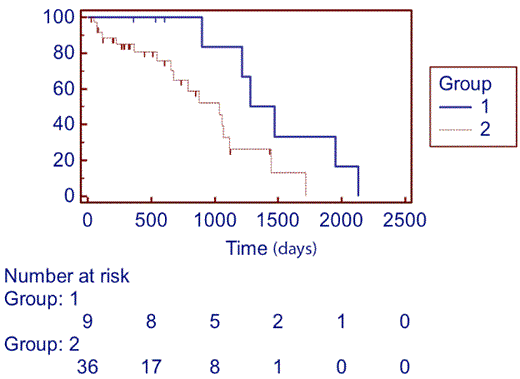Abstract
Introduction: Many patients with Acute Myelogenous Leukemia (AML) will transiently develop blasts in the peripheral blood upon recovery of induction chemotherapy, despite going on to obtain a complete remission. These are presumably non-leukemic marrow blasts. Recovery blasts can sometimes reach over 20% in the peripheral blood in remission patients. The significance of recovery blasts cells after induction chemotherapy in patients with AML is not clear. We sought to define the incidence of recovery blastocytosis (RB) and determine if the presence of RB has prognostic relevance.
Methods: We performed a retrospective analysis of 72 patients with newly diagnosed AML who underwent induction chemotherapy with 7+3 (cytarabine and daunorubicin) with or without etoposide between the years of 2006 and 2013 at our institution. Patients were included in the analysis as having RB only if their blasts resolved by day 14 of induction chemotherapy, blasts reappeared upon recovery after day 14, recovery blasts were > 5% in the peripheral blood of a duration of >5 days, and subsequently resolved by day 45 and remission was obtained. We recorded patient's absolute and percentage peripheral blast counts on presentation, upon nadir and throughout recovery of induction chemotherapy. The incidence and level of RB in patients who achieved a remission was tabulated. This group (group 1) was compared to the patients who achieved a remission whom did not develop RB (group 2).
Results: 45/77 AML patients obtained a CR after induction chemotherapy. Recovery blasts were seen in 9/45 (20%) remission patients (group 1), with a median RB of 9% for a median duration of 8 days. Of these 9 patients, 4 developed RB > 10%, and 2 developed RB >20 % Group 1 did not differ in respect to age, gender, cytogenetic profile, etoposide use, or whether the patient received 1 or 2 induction therapies from the 36/45 remission AML patients who did not develop RB (group 2). Median survival for group 1 was = 1,376 days, and 1,036 days for group 2 (p= .035).
Conclusion: Recovery Blasts in the peripheral blood after induction chemotherapy is seen commonly in AML patients who obtain a complete remission. RB can be seen even as high as > 20% in remission patients. AML patients who develop RB on their way to remission after induction chemotherapy have a better overall survival then patients who do not develop RB.
Graph 1. Kaplan-Meier survival curves for AML patients with RB (group 1) and without RB (group 2).
No relevant conflicts of interest to declare.
Author notes
Asterisk with author names denotes non-ASH members.


This feature is available to Subscribers Only
Sign In or Create an Account Close Modal